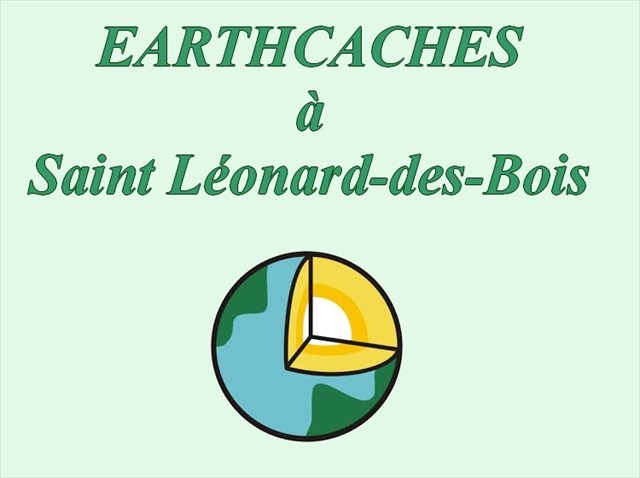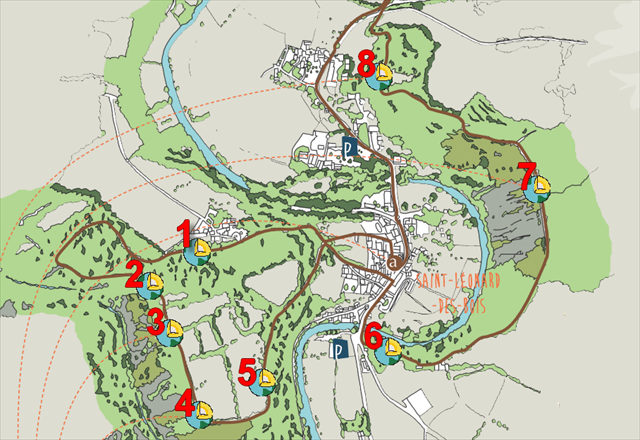
|
 |

|
Cette série de 8 earthcachesest située sur le sentier intitulé "Histoires Géologiques". Chaque earthcache se trouve à l'emplacement d'un panneau informatif. Ce parcours vous permet de retracer 600 millions d'annéesd'histoire qui ont formé les roches et façonné le paysage. Le circuit, long de 10 kilomètres(3 heures environ), avec de forts dénivelés, est balisé et fléché en brun.
ATTENTION! Le parcours est fléché dans un seul sens, à l'inverse des aiguilles d'une montre. Les parkings et le point de départ du sentier sont indiqués en waypoints additionnels.
|
This series of 8 Earthcaches is on the trail entitled "Geological Stories". Each earthcache is located in the vicinity of an information board. This tour allows you to trace 600 million years of a history of geological events that formed the rocks and shaped the landscape. The circuit, 10 kilometers long (about 3 hours), with steep climbs, is marked and signposted in brown.
WATCH OUT! The tour is signposted in one direction, anticlockwise. Car parks and the starting point of the trail are in additional waypoints.
|
 |
Toutes les roches sont sujettes à transformation sous l’effet de la chaleur et de la pression. C’est le métamorphisme. Les transformations les plus importantes ont lieu dans les profondeurs terrestres où pressions et températures sont élevées ? On trouve parmi les schistes les roches métamorphiques les plus communes.
La caractéristique fondamentaledu schiste métamorphisé est sa « foliation », ou « schistosité ». Les mouvements tectoniques compressent la roche sédimentaire, du schiste, créant des « clivages en feuillets ».
L’ardoiseappartient à la famille des schistes ; elle est caractérisée par la finesse de son grain et de ses feuilles. Elle s’est formée sous de faibles pressions et températures. Facile à exploiter et à découper elle constitue un matériau de choix pour les toitures.
En raison de leur « schistosité », les schistes de Saint-Léonard-des-bois qui affleurent autour de nous, ont été exploités pour faire des ardoises.
Deux carrièresont été exploitées au milieu du 19e siècle. Ces ardoisières ont fermé vers 1860. A cause de la présence de fer sous forme de « pyrite », les ardoises de Saint-Léonard n’étaient pas très réputées, car sujettes à la rouille.
|
|
 |
|
|
All rock is subject to transformation under the effect of heat and pressure this process and this is called metamorphism. The most significant transformation takes place deep in the earth where both pressure and temperature are very high. Shale is one of the most common forms of metamorphic rock.
A major feature of metamorphosed shale is its « schistosity », the facility to split into layers. Tectonic movement compresses sedimentary shale, creating sheets by cleavage.
Slate belongs to the shale family ; it has minute grains and splits into very thin layers. It is formed at low pressure and temperature. Easy to extract and to cut, it is an ideal roofing material. It is quarried in blocks which are then divided up, split and cut to shape.
The Ordovician shale of Saint-Léonard-des-bois, which is visible all around us, was quarried for making roofing slates.
Two quarries were worked in the mid-nineteenth century. They closed around 1860. Since iron ore was present in the form of pyrite, the slate from Saint-Léonard was subject to rusting and led to its poor reputation.
|
Comment valider votre visite ?
Allez aux coordonnées indiquées au début de ce descriptif. Vous trouverez un panneau d'information. Afin de valider votre visite, vous devez répondre aux questions suivantes :
1) Que contient le schiste ordovicien, roche sédimentaire métamorphisée ?
2) Qu'est-ce qui a permis de dater les gisements d'ardoise de Saint-Léonard ?
3) Pourquoi les ardoisières ont fermé ?
Allez aux coordonnées du waypoint 2.
4) Quelle est l'orientation du mur d'ardoise ?
5) OBLIGATOIRE : prenez une photo de vous, de votre GPS ou d’un objet personnel, à joindre avec votre log, avec le mur d'ardoise en arrière-plan. (Guidelines des earthcaches du 10 juin 2019).
Envoyez vos réponses par mail ou messagerie geocaching. Inutile d'attendre ma validation pour logguer un "Found it", mais si vous oubliez de me fournir les réponses, votre log sera supprimé.
|
How to validate your visit !
Go to the coordinates indicated at the top of this page. Here you will find an information board. In order to validate your visit, you have to answer the following questions:
1) What is in the Ordovician shale, metamorphosed sedimentary rock ?
2) What helped to date the slate deposits of Saint-Leonard ?
3) Why the slate quarries have closed ?
Go to the coordinates of the waypoint 2.
4) What is the orientation of the slate wall ?
5) MANDATORY : take a picture of yourself, your GPSr or a personal object, to be attached with your log, with the slate wall in the background. (Earthcaches guidelines of June 10, 2019).
Send me your answers via mail or Geocaching Message Center (e-mail on my profile). You do not need to wait for my validation to log a "Found it" but if you forget to send me your answers, your log will be deleted.
|
|
|